[jump to the lahm bi ajeen recipe]
My cousin, Kris, spends all of his time creating beautiful things. He is a talented computer programmer and graphic designer, and he spends a lot of his free time making delicious food. Kris’ cooking is equal parts improvisation and precision; he uses his knowledge of food science and technique, but he’s also an inventive and spontaneous cook. He’s the type of person who can take random leftover ingredients from the refrigerator and make something new and delicious. But he’s also always working on and perfecting his favorite dishes, like his recipe for lahm bi ajeen. He taught me how to make it a few weeks ago, and kindly let me share his recipe with you.
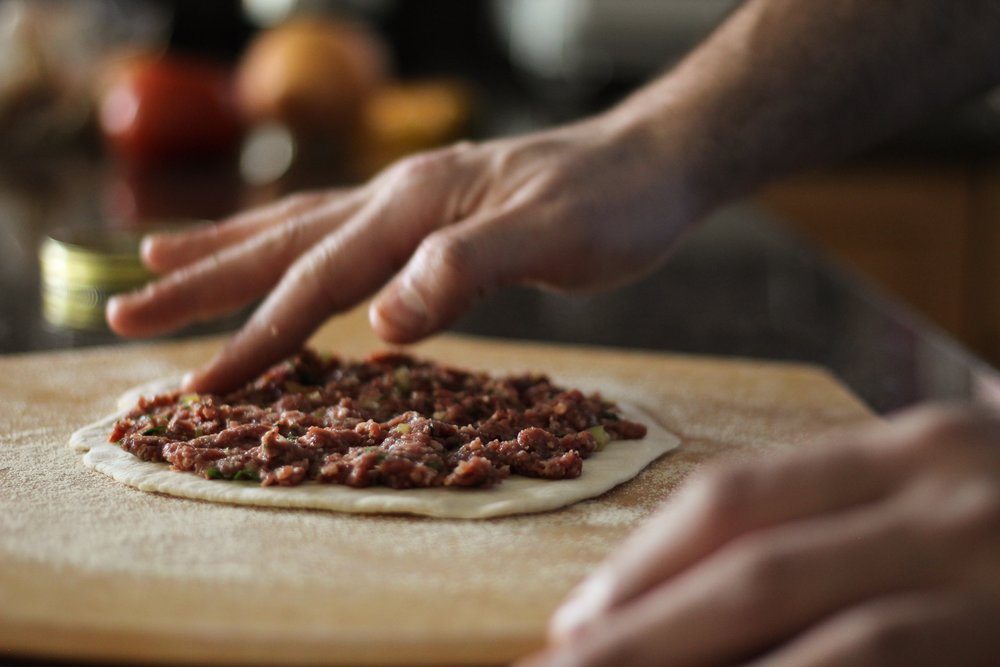
Lahm bi ajeen (AKA laham b’ajeen, lahmajun, or lahmajoun) is usually described as Middle Eastern meat pizza. But there are some ways that the comparison doesn’t begin to do justice to lahm bi ajeen’s unique flavor. Sure, each dish is thinly rolled dough baked with toppings on a hot stone. But instead of layering dough, tomato sauce, cheese, and toppings, you mix the tomato sauce in with the meat, you skip the cheese altogether, and you add a bunch of intensely flavorful ingredients, like pomegranate molasses/paste, parsley, and peppers. Pomegranate molasses is unbearably tart on its own, but it adds a lovely sweet and sour flavor to ground beef. It’s the true star of the recipe and simply can’t be substituted.
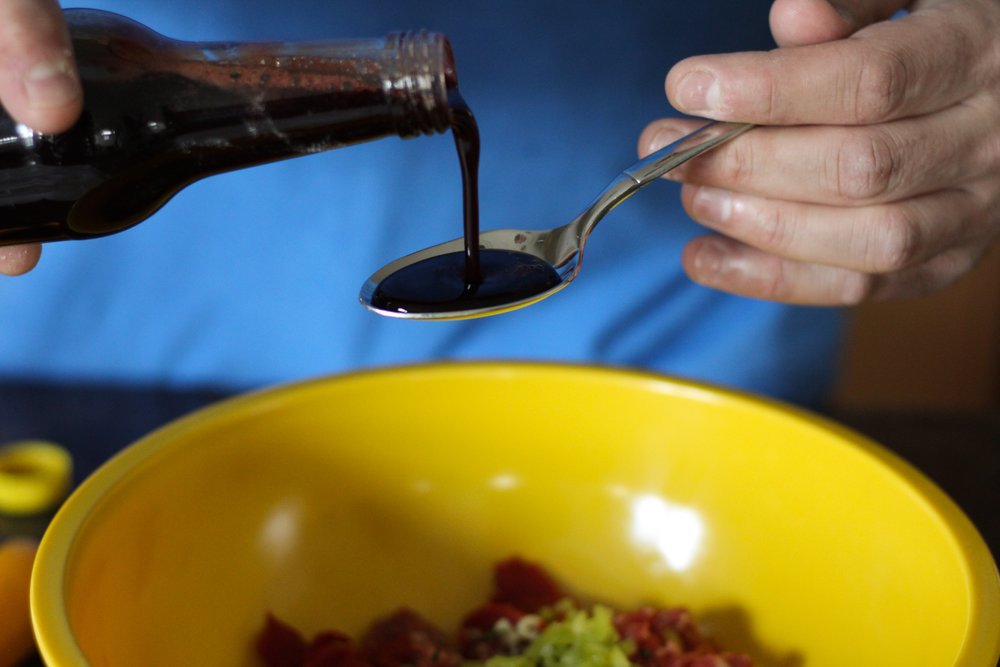
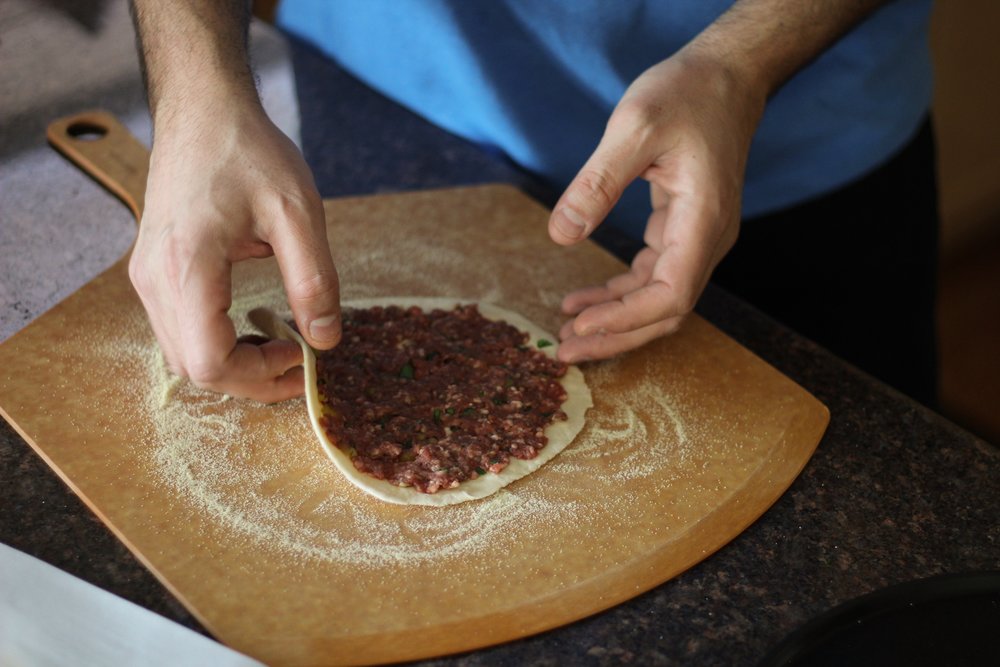
pomegranate molasses
You’ll rarely (although not never!) find pomegranate molasses in the average American supermarket, but it’s a staple of Middle Eastern grocery stores. It’s also very easy to make yourself, if you can’t find it near you (and makes the house smell dreamy). When I’ve made pomegranate molasses at home, it has never turned out quite as tangy as the stuff from the store, but it has its own interesting, subtle flavor. If all else fails, you can very easily find it online.
If you’re worried about investing in a specialty ingredient that you’ll only use one time for this one recipe, then I’m here to tell you that no one has ever had this problem in the history of pomegranate molasses. There are a lot of traditional dishes that call for it. But it’s also the kind of thing you can just throw in with your favorite recipe to make it extra-special. For instance, it’s a wonderful simple syrup substitute in cocktails and mocktails, it works fabulously as part of a marinade for meat or veggies, and you can spoon it over or swirl it into just about any dessert. Any time you want some sweetness and tartness, it’s the perfect thing.
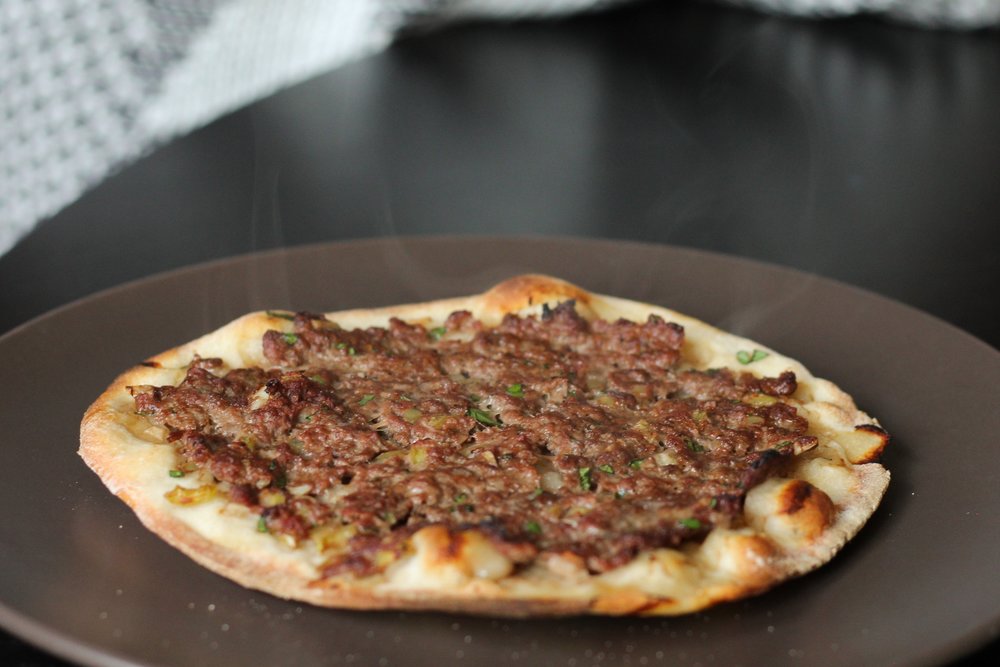
lahm bi ajeen | middle eastern pizzas

For an easier recipe, try this alternative
- Total Time: between 4 and 26 hours
- Yield: 8 small pies
Ingredients
For the dough:
- 1 1/2 teaspoons active dry yeast
- 1/2 teaspoon sugar
- 1 1/2 cups room temperature water, divided into 1 cup and 1/2 cup
- 12 ounces (2 cups) all purpose flour
- 5 ounces (1 cup) 00 flour (or substitute additional all purpose flour)
- 3/4 teaspoon salt
For the meat mixture:
- 1 pound 5 ounces lean, ground beef
- 2 1/2 tablespoons pomegranate paste/molasses (see ingredient note preceding the recipe)
- 2 tablespoons tomato paste
- 1 banana pepper, minced
- 1/4 cup chopped parsley, loosely packed
- 1/2 small onion, minced
- 3/4 teaspoon salt (plus more to taste, if you prefer)
- 1/4 teaspoon ground black pepper
To bake the pies:
- Additional flour, for sprinkling
- Semolina or cornmeal, for sprinkling
- Ground meat mixture
- Risen dough
- Finishing salt
Instructions
- Make the dough: Proof the active dry yeast with the sugar and 1 cup of the water until the water looks a little foamy on top (about 5-10 minutes).
- Add the all purpose flour, 00 flour, and salt to a bowl (the bowl of a stand mixer, if you plan to knead by machine).
- Add the water/yeast/sugar mixture and stir until the dough starts to come together into a dry, shaggy mess.
- Gradually add a little of the remaining 1/2 cup of water at a time, about 1 tablespoon at a time, until the whole thing comes into a dough ball. Do not use all of the water, unless you need it. If you use too much water, compensate with a little more flour; likewise, if the dough looks too dry, add a little more water and let it sit for a few minutes to absorb. The dough ball should not be too sticky or dry (somewhere in between is best). It should look a tiny bit firmer than store-bought pizza dough.
- Knead until the dough ball passes the window pane test. It should come together into an elastic ball that has a smooth surface. Kneading should take about 5-15 minutes by machine with a dough hook, or 10-20 minutes by hand. Pay more attention to the dough’s consistency than the time you’ve spent kneading.
- Place the dough in a bowl, cover it, and let it sit at room temperature for 20 minutes, and then in the refrigerator overnight. If you don’t have time to wait overnight, you can let it rise at room temperature for 1 1/2 to 2 hours (resting it in the refrigerator will help it develop a better flavor and texture).
- Make the meat mixture: Combine the ground beef, pomegranate molasses, tomato paste, banana pepper, parsley, onion, salt, and pepper, being careful not to over-mix.
- Shape and bake the pies: Lightly flour a clean, food-safe work surface, use a knife or bench scraper to divide the dough into 8 equal pieces, and shape each chunk into a round ball.
- Place a pizza stone (or sheet pan) on the oven floor, move the oven racks up and out of the way, so you can easily access the pizza stone, and pre-heat the oven to 500° F.
- Roll each dough ball into a circle, about 1/8 inch thick. This is very thin, but not paper-thin (see above photos). To keep the round shape, rotate the disc about 90 degrees after each time you roll it out, and be sure to re-flour the surface every so often. Separate the discs with wax paper and let them rise for about 25 minutes.
- Divide the ground meat mixture into about 8 equal pieces.
- Sprinkle a pizza peel (or rimless sheet pan) with a tablespoon or two of semolina or cornmeal.
- Place a rolled-out disc of dough on the semolina/cornmeal.
- Put one of the pieces of meat on top of the dough disc. Work the meat into a thin, even layer over the dough, so that it doesn’t separate from the crust and shrink to the center as it cooks. Sprinkle with a little additional salt, if you’d like.
- Once the oven has preheated, use a quick motion to move the pie from the pizza peel onto the pizza stone. Cook for about 5 minutes, until the meat starts to brown and the bread is cooked through and starting to char. The dough should be crispy and chewy, like really good brick oven pizza.
- Repeat with the remaining 7 pies.
Notes
Kris’ dough recipe is phenomenal, but if you don’t have time and still want to make this recipe, feel free to use store-bought pizza dough. It won’t be quite the same, but it’ll still be delicious.

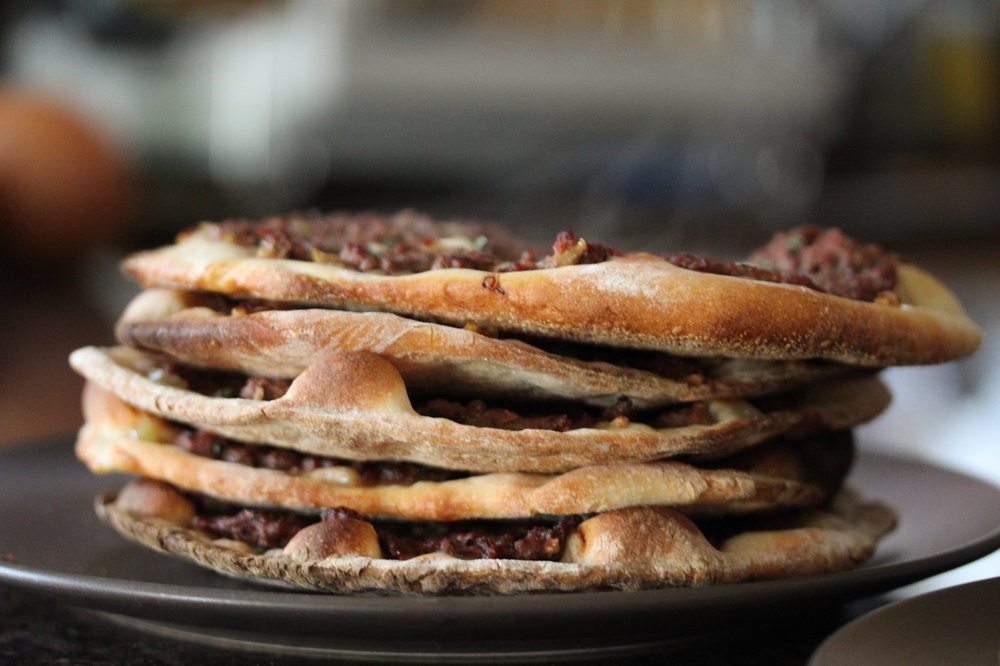

This recipe looks incredible, thank you for sharing. One staple use of pomegranate molasses is as a substitute for lemon in salad dressing. This is how I go through almost two bottles during Ramadan!
Oh absolutely—that is a great idea! It’s always lovely to break the fast with anything made with pomegranate molasses! <3
I love this recipe! The dough is crispy and chewy at the same time, and the meat stuffing is nice and tangy.
★★★★★